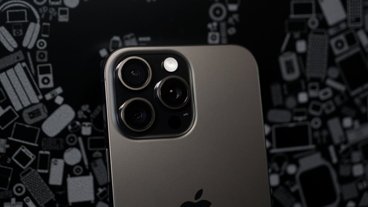The shift puts an end to the RAZR's three-year run atop the market, with the Motorola handset falling to the second slot, followed by Research in Motion's Blackberry Curve, LG's Rumor, and LG's enV2, respectively.
"The displacement of the RAZR by the iPhone 3G represents a watershed shift in handset design from fashion to fashionable functionality," said Ross Rubin, director of industry analysis for NPD. "Four of the five best-selling handsets in the third quarter were optimized for messaging and other advanced Internet features."
Despite stronger consumer sales of iPhone, the mobile phone segment failed to see its normal seasonal jump following the close of the second quarter, with domestic handset sales to adult consumers declining 15 percent year over year in the third quarter to 32 million units. Similarly, consumer handset sales revenue fell 10 percent to $2.9 billion, even as the average selling price (ASP) rose 6 percent to $88.
Word of the iPhone's rising popularity amongst average consumers comes just weeks after Apple announced that it sold more handsets in the third quarter than rival Research in Motion, making it the second largest smartphone manufacturer in the world by volume. NPD says it does not track corporate or enterprise handset purchases.
When it comes to the specific features that motivated U.S. consumers to purchase last quarter, the firm said 43 percent of handset buyers cited the need for a camera and 36 percent noted the ability to send and receive text messages.
Still, phones with a physical QWERTY keyboard experienced the greatest year-over-year rise in sales, according to NPD. About 30 percent of handsets sold during the quarter had this feature, up from just 11 percent the year prior. In addition, 83 percent of phones purchased by consumers were Bluetooth enabled (versus 72 percent last year), and nearly seven in 10 (68 percent) of phones purchased were music enabled (versus 49 percent last year).
"A growing data divide continues in cellular handsets," Rubin said. "Those who see the value in wireless Internet access are justifying the investment, whereas voice-centric users have little incentive to upgrade, which is obviously detrimental to operators who seek to sell data plans and media access services to their subscribers."
NPD says its reports on the matter are compiled based on an analysis of mobile device sales data based on more than 150,000 completed online consumer research surveys each month.
 Slash Lane
Slash Lane






-m.jpg)






 Charles Martin
Charles Martin
 Marko Zivkovic
Marko Zivkovic
 Andrew Orr
Andrew Orr
 Amber Neely
Amber Neely

 William Gallagher and Mike Wuerthele
William Gallagher and Mike Wuerthele










25 Comments
OMG!
Geez, watch the rise of Apple, the world's next biggest phone marketer.
You think Apple will take over the phone industry like it did the mobile media player industry?
"A growing data divide continues in cellular handsets," Rubin said. "Those who see the value in wireless Internet access are justifying the investment, whereas voice-centric users have little incentive to upgrade, which is obviously detrimental to operators who seek to sell data plans and media access services to their subscribers."
Oh, poor telecoms: should I weep for you?
I must say, I have yet to be convinced that I need the internet with me at all times. I'd rather have a new Macbook than a new iPhone. Good for Apple on both fronts, however...
OMG!
Geez, watch the rise of Apple, the world's next biggest phone marketer.
You think Apple will take over the phone industry like it did the mobile media player industry?
The article is misleading. "NPD says it does not track corporate or enterprise handset purchases". This is the majority of Blackberry sales.
Apple are not the 2nd largest by volume as stated in the article - in fact they have just 1 to 2% of the market by volume. Steve Jobs clearly stated they are 2nd by revenue because they sell such an expensive phone and their revenue is based on how much the carriers are willing to subsidise the iPhone to have it on their network. It has been claimed that Apple receive in the order of $600 per phone (Retail $699 without contract, or normally subsidy of from $325 to $399 from AT&T/network provider in country). Furthermore, do all other manufacturers count phones in the distribution channel? Apple stated they have around 2 million of the 6.5 million sales "in the channel". Furthermore, there was massive pent-up demand from the 2 months that Apple couldn't offer a phone for sale because they stopped selling the 2G. Let us see what the figures are next quarter before we really know just how big a player Apple has become. Personally, I can't wait for Microsoft's Ballmer to eat his words as Windows mobile falls into irrelevance.
Personally, I can't wait for Microsoft's Ballmer to eat his words as Windows mobile falls into irrelevance.
What do you mean? Here I was under the impression this had already happened, other than the "Ballmer eating his words" part.